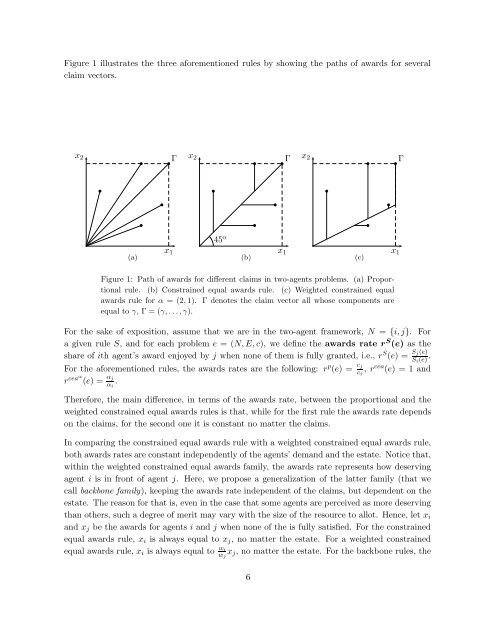STRONG COMPOSITION DOWN. CHARACTERIZATIONS OF ... - Ivie
You also want an ePaper? Increase the reach of your titles
YUMPU automatically turns print PDFs into web optimized ePapers that Google loves.
•<br />
•<br />
•<br />
•<br />
•<br />
•<br />
•<br />
•<br />
•<br />
•<br />
•<br />
•<br />
•<br />
Figure 1 illustrates the three aforementioned rules by showing the paths of awards for several<br />
claim vectors.<br />
[Insert Figure 1 about here.]<br />
x 2<br />
•<br />
Γ<br />
x 2<br />
•<br />
Γ<br />
x 2<br />
Γ<br />
45 o<br />
(a)<br />
x 1<br />
(b)<br />
x 1<br />
(c)<br />
x 1<br />
Figure 1: Path of awards for different claims in two-agents problems. (a) Proportional<br />
rule. (b) Constrained equal awards rule. (c) Weighted constrained equal<br />
awards rule for α = (2, 1). Γ denotes the claim vector all whose components are<br />
equal to γ, Γ = (γ, . . .,γ).<br />
For the sake of exposition, assume that we are in the two-agent framework, N = {i,j}. For<br />
a given rule S, and for each problem e = (N,E,c), we define the awards rate r S (e) as the<br />
share of ith agent’s award enjoyed by j when none of them is fully granted, i.e., r S (e) = S j(e)<br />
S i (e) .<br />
For the aforementioned rules, the awards rates are the following: r p (e) = c j<br />
c i<br />
, r cea (e) = 1 and<br />
r ceaα (e) = α j<br />
α i<br />
.<br />
Therefore, the main difference, in terms of the awards rate, between the proportional and the<br />
weighted constrained equal awards rules is that, while for the first rule the awards rate depends<br />
on the claims, for the second one it is constant no matter the claims.<br />
In comparing the constrained equal awards rule with a weighted constrained equal awards rule,<br />
both awards rates are constant independently of the agents’ demand and the estate. Notice that,<br />
within the weighted constrained equal awards family, the awards rate represents how deserving<br />
agent i is in front of agent j. Here, we propose a generalization of the latter family (that we<br />
call backbone family), keeping the awards rate independent of the claims, but dependent on the<br />
estate. The reason for that is, even in the case that some agents are perceived as more deserving<br />
than others, such a degree of merit may vary with the size of the resource to allot. Hence, let x i<br />
and x j be the awards for agents i and j when none of the is fully satisfied. For the constrained<br />
equal awards rule, x i is always equal to x j , no matter the estate. For a weighted constrained<br />
equal awards rule, x i is always equal to w i<br />
w j<br />
x j , no matter the estate. For the backbone rules, the<br />
5

















